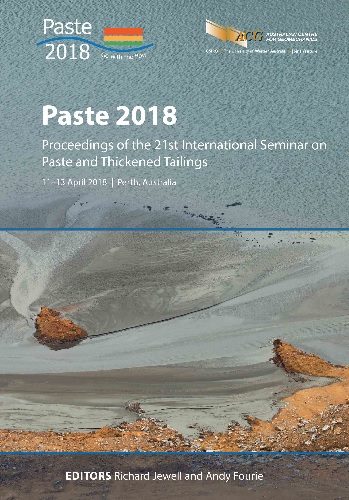Pitfalls in interpretation of cone penetration test data recovered from unsaturated geomaterials

|
Authors: Russell, AR; Reid, D |
DOI https://doi.org/10.36487/ACG_rep/1805_40_Russell
Cite As:
Russell, AR & Reid, D 2018, 'Pitfalls in interpretation of cone penetration test data recovered from unsaturated geomaterials', in RJ Jewell & AB Fourie (eds), Paste 2018: Proceedings of the 21st International Seminar on Paste and Thickened Tailings, Australian Centre for Geomechanics, Perth, pp. 483-492, https://doi.org/10.36487/ACG_rep/1805_40_Russell
Abstract:
Laboratory-controlled and field cone penetration test (CPT) results for unsaturated geomaterials (sands, silty sands, tailings) show that suction has a pronounced influence. The penetration resistances increase significantly due to the presence of suction when compared to those for saturated or dry states, for a given relative density and net confining stress. For unsaturated sands, when suction is included in the effective stress, the same semi-empirical expressions used for saturated conditions are found to link penetration resistance to the relative density and effective confining stress. However, the same is not true for unsaturated silty sands, as saturated and unsaturated silty sands behave very differently around a penetrating cone. Suction also has implications when using classification charts. Cone penetration test results from a range of soils and tailings for both saturated and unsaturated conditions are plotted in one type of chart. Suctioninduced increases in penetration resistances, and changes of soil behaviours from partially drained/undrained to drained cause incorrect classifications and assessments that geomaterials are dilative. Failure to account for suction influences, and the altered material response, may also lead to overestimation of cyclic resistance ratio.
Keywords: cone penetration test (CPT), suction, unsaturated, strength, classification, cyclic resistance ratio
References:
Baldi, G, Bellotti, R, Ghionna, V, Jamiolkowski, M & Pasqualini, E 1982, ‘Design parameters for sands from CPT’, Proceedings of the Second Euro Symposium on Penetration Test, vol. 2, A.A. Balkema, Rotterdam, pp. 425–432.
Bishop, AW 1959, ‘The principle of effective stress’, Teknisk Ukeblad, vol. 106, pp. 859–863.
Blight, GE 2013, Unsaturated Soil Mechanics in Geotechnical Practice, CRC Press, Boca Raton.
Collins, R & Miller, GA 2014, ‘Cone penetration testing in unsaturated soils at two Instrumented test sites’, Proceedings of the 6th International Conference on Unsaturated Soils, vol. 2, A.A. Balkema, Lisse, pp. 1489–1494.
Jamiolkowski, M, Lo Presti, DCF & Manassero, M 2003, ‘Evaluation of relative density and shear strength of sands from CPT and DMT’, Soil Behavior and Soft Ground Construction, ASCE Geotechnical Special Publication 119, pp. 201–238.
Lee, KM, Shen, CK, Leung, DHK & Mitchell, JK 1999, ‘Effects of placement method on geotechnical behaviour of hydraulic fill sands’, Journal of Geotechnical and Geoenvironmental Engineering, vol. 125, no. 10, pp. 832–846.
Lehane, B, Ismail, MA & Fahey, M 2004, ‘Seasonal dependence of in situ test parameters in sand above the water table’, Géotechnique, vol. 54, no. 3, pp. 215–218.
Olsen, RS & Farr, V 1986, ‘Site characterization using the cone penetration test’, in SP Clemence (ed.), Proceedings of In-Situ 86, American Society of Civil Engineers, Reston, pp. 854–868.
Pournaghiazar, M, Russell, AR & Khalili, N 2011, ‘Development of a new calibration chamber for conducting cone penetration tests in unsaturated soils’, Canadian Geotechnical Journal, vol. 48, no. 2, pp. 314–321.
Pournaghiazar, M, Russell, AR & Khalili, N 2013, ‘The cone penetration test in unsaturated sands’, Géotechnique, vol. 63, no. 14,
pp. 1209–1220.
Robertson, PK 2010, ‘Evaluation of flow liquefaction and liquefied strength using the cone penetration test’, Journal of Geotechnical and Geoenvironmental Engineering, vol. 136, no. 6, pp. 846–853.
Robertson, PK & Campanella, RG 1983a, ‘Interpretation of cone penetration tests. Part I: sand’, Canadian Geotechnical Journal,
vol. 20, no. 4, pp. 718–733.
Robertson, PK & Campanella, RG 1983b, ‘Interpretation of cone penetration tests. Part II: clay’, Canadian Geotechnical Journal,
vol. 20, no. 4, pp. 734–745.
Robertson, PK & Wride, CE 1998, ‘Evaluating cyclic liquefaction potential using the cone penetration test’, Canadian Geotechnical Journal, vol. 35, pp. 442–459.
Russell, AR & Khalili, N 2006a, ‘A unified bounding surface plasticity model for unsaturated soils’, International Journal for Numerical and Analytical Methods in Geomechanics, vol. 30, no. 3, pp. 181–212.
Russell, AR & Khalili, N 2006b, ‘On the problem of cavity expansion in unsaturated soils’, Computational Mechanics, vol. 37, no. 4, pp. 311–330.
Schmertmann, JH 1978, Guidelines for Cone Penetration Test: Performance and Design, Federal Highway Administration report FHWA-TS-78209, United States Federal Highway Administration, Washington, DC, 148 p.
Yang, H, Khoshghalb, A & Russell, AR 2014, ‘Fractal-based estimation of hydraulic conductivity from soil-water characteristic curves considering hysteresis’, Géotechnique Letters, vol. 4, pp. 1–10.
Yang, H & Russell, AR 2015, ‘Cavity expansion in unsaturated soils exhibiting hydraulic hysteresis considering three drainage conditions’, International Journal for Numerical and Analytical Methods in Geomechanics, vol. 39, pp. 1975–2016.
Yang, H & Russell, AR 2016, ‘The cone penetration test in an unsaturated silty sand’, Canadian Geotechnical Journal, vol. 53, no. 3, pp. 431–444.
© Copyright 2025, Australian Centre for Geomechanics (ACG), The University of Western Australia. All rights reserved.
View copyright/legal information
Please direct any queries or error reports to repository-acg@uwa.edu.au
View copyright/legal information
Please direct any queries or error reports to repository-acg@uwa.edu.au



